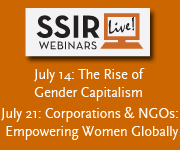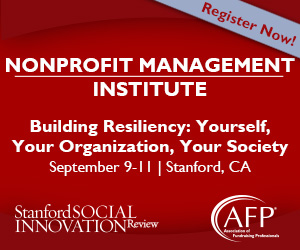ISSUE
Articles on social change from the latest edition of SSIR

Spring 2007
Volume 5, Number 2
Everybody loves social entrepreneurship, and everybody wants to be one, too. Unfortunately, with popularity comes confusion—all sorts of activities are now being called social entrepreneurship. In the spring 2007 issue of Stanford Social Innovation Review, Roger L. Martin and Sally Osberg make “The Case for Definition,” arguing that there must be some distinction between those who are truly practicing social entrepreneurship and those who just wish they were.
Features
How Nonprofits Get Really Big
Since 1970, more than 200,000 nonprofits have opened in the U.S., but only 144 have reached $50 million in annual revenue. They got big by doing two things: They raised the bulk of their money from a single type of funder. And just as importantly, these nonprofits created professional organizations that were tailored to the needs of their primary funding sources.
Luck of the Draw
Grantees of foundations have little control over which program officer takes their case. Yet program officers make or break grantees’ experiences with foundations. To trigger social change, foundations must give program officers better training, clearer expectations, and regular performance feedback.
Learn to Love Lobbying
Most nonprofits don’t know how to lobby and, worse, think that it entails cutting shady deals with sleazy characters. Yet lobbying is nothing more than educating legislators – a right that our democracy guarantees. To make change, nonprofits must learn to lobby. And who knows? They may even learn to love it.
Field Report
Policing the Police
The traditional approach among human rights groups in Nigeria had been accusatory: publicize injustices or sue the government. But in January 1998, on the eve of democracy, an NGO called the CLEEN foundation set out to reform law enforcement from within.
Bettering Beantown
Greenlight is a nonprofit catalyst: It identifes a local need, scours the country for the best program to meet it, and then establishes a chapter in its hometown.
Secret Agents
Find out why Method home products keep their eco-friendliness under very attractive wraps.
Viewpoint
Sound and Fury
Much public affairs lingo, such as "capacity," signifies nothing in particular. The nonprofit and public sectors have more than their share of this vocabulary. There are a handful of toxic words and phrases that have a way of polluting any stream of consciousness, muddying the concepts and making it impossible to see what facts and arguments (if any) lie below the surface.
Profiting From Failure
What nonprofits and donors can learn from the closing of a venture philanthropy firm.
Research
The Seven Habits of Highly Effective Health Partnerships
Step aside, Stephen Covey. Kent Buse and Andrew M. Harmer have discovered seven new highly effective habits. And theirs may help rid the world of its more deadly diseases, rather than just upping people's productivity.
Your Brain on Drug Addicts
Recent neuroscience research confirms that people - and the brains they contain - view drug addicts as not quite human.
No Substitute for Experience
When hiring executives, many nonprofits should seek marketing expertise.
The Crown Weighs Heavily on the Eyelids
Why the powerful have a hard time taking other people’s perspectives.
Books
Review: The Foundation vs. Great Philanthropic Mistakes
Some books ought to be read as pairs. Joel L. Fleishman’s and Martin Morse Wooster’s recent offerings are such a duo, offering sometimes diametrically opposed perspectives on philanthropic successes and failures.
Review: The Business of Changing the World
Twenty Great Leaders on Strategic Corporate Philanthropy.
Q&A
15 Minutes with Kevin Johnson
SSIR Academic Editor Jim Phills sat down with former NBA superstar Kevin Johnson to discuss how he's revitalizing his old inner-city neighborhood.
 → This form is for US/Canada subscribers. Are you an international subscriber?
→ This form is for US/Canada subscribers. Are you an international subscriber?
Click here instead.
Subscribe Now!
Subscribers get premium online access (articles with a key) including 9-year archive, downloadable digital edition, quarterly print issues (optional).
































































